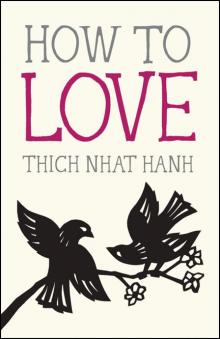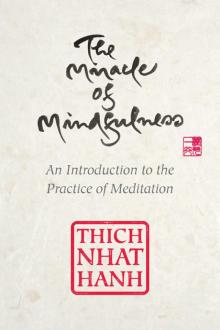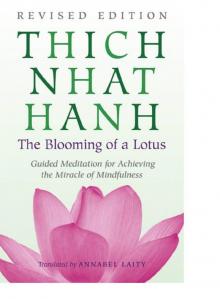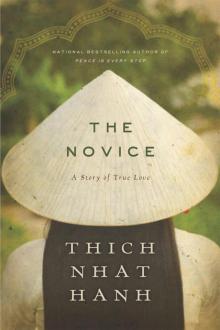- Home
- Thich Nhat Hanh
How to Love
How to Love Read online
CONTENTS
Notes on Love
Practices for Nourishing True Love
NOTES ON LOVE
HEART LIKE A RIVER
If you pour a handful of salt into a cup of water, the water becomes undrinkable. But if you pour the salt into a river, people can continue to draw the water to cook, wash, and drink. The river is immense, and it has the capacity to receive, embrace, and transform. When our hearts are small, our understanding and compassion are limited, and we suffer. We can’t accept or tolerate others and their shortcomings, and we demand that they change. But when our hearts expand, these same things don’t make us suffer anymore. We have a lot of understanding and compassion and can embrace others. We accept others as they are, and then they have a chance to transform. So the big question is: how do we help our hearts to grow?
FEEDING OUR LOVE
Each of us can learn the art of nourishing happiness and love. Everything needs food to live, even love. If we don’t know how to nourish our love, it withers. When we feed and support our own happiness, we are nourishing our ability to love. That’s why to love means to learn the art of nourishing our happiness.
UNDERSTANDING IS THE NATURE OF LOVE
Understanding someone’s suffering is the best gift you can give another person. Understanding is love’s other name. If you don’t understand, you can’t love.
RECOGNIZING TRUE LOVE
True love gives us beauty, freshness, solidity, freedom, and peace. True love includes a feeling of deep joy that we are alive. If we don’t feel this way when we feel love, then it’s not true love.
REVERENCE IS THE NATURE OF OUR LOVE
There’s a tradition in Asia of treating your partner with the respect you would accord a guest. This is true even if you have been with your loved one for a long time. The other person always deserves your full respect. Reverence is the nature of our love.
LOVE IS EXPANSIVE
In the beginning of a relationship, your love may include only you and the other person. But if you practice true love, very soon that love will grow and include all of us. The moment love stops growing, it begins to die. It’s like a tree; if a tree stops growing, it begins to die. We can learn how to feed our love and help it continue to grow.
LOVE IS ORGANIC
Love is a living, breathing thing. There is no need to force it to grow in a particular direction. If we start by being easy and gentle with ourselves, we will find it is just there inside of us, solid and healing.
DISTRACTIONS
Often, we get crushes on others not because we truly love and understand them, but to distract ourselves from our suffering. When we learn to love and understand ourselves and have true compassion for ourselves, then we can truly love and understand another person.
THE FOUR ELEMENTS OF TRUE LOVE
True love is made of four elements: loving kindness, compassion, joy, and equanimity. In Sanskrit, these are, maitri, karuna, mudita, and upeksha. If your love contains these elements, it will be healing and transforming, and it will have the element of holiness in it. True love has the power to heal and transform any situation and bring deep meaning to our lives.
LOVING KINDNESS
The first element of true love is loving kindness. The essence of loving kindness is being able to offer happiness. You can be the sunshine for another person. You can’t offer happiness until you have it for yourself. So build a home inside by accepting yourself and learning to love and heal yourself. Learn how to practice mindfulness in such a way that you can create moments of happiness and joy for your own nourishment. Then you have something to offer the other person.
COMPASSION
The second element of true love is compassion. Compassion is the capacity to understand the suffering in oneself and in the other person. If you understand your own suffering, you can help him to understand his suffering. Understanding suffering brings compassion and relief. You can transform your own suffering and help transform the suffering of the other person with the practice of mindfulness and looking deeply.
JOY
The third element of true love is the capacity to offer joy. When you know how to generate joy, it nourishes you and nourishes the other person. Your presence is an offering, like fresh air, or spring flowers, or the bright blue sky.
EQUANIMITY
The fourth element of true love is equanimity. We can also call it inclusivesness or nondiscrimination. In a deep relationship, there’s no longer a boundary between you and the other person. You are her and she is you. Your suffering is her suffering. Your understanding of your own suffering helps your loved one to suffer less. Suffering and happiness are no longer individual matters. What happens to your loved one happens to you. What happens to you happens to your loved one.
RESPECT AND TRUST
Along with the traditional four elements of true love—loving kindness, compassion, joy, and equanimity—there are two more elements: respect and trust. These elements can be found in the four, but it helps to mention their names. When you love someone, you have to have trust and confidence. Love without trust is not yet love. Of course, first you have to have trust, respect, and confidence in yourself. Trust that you have a good and compassionate nature. You are part of the universe; you are made of stars. When you look at your loved one, you see that he is also made of stars and carries eternity inside. Looking in this way, we naturally feel reverence. True love cannot be without trust and respect for oneself and for the other person.
BE BEAUTIFUL, BE YOURSELF
If you can accept your body, then you have a chance to see your body as your home. You can rest in your body, settle in, relax, and feel joy and ease. If you don’t accept your body and your mind, you can’t be at home with yourself. You have to accept yourself as you are. This is a very important practice. As you practice building a home in yourself, you become more and more beautiful.
YOU ARE A FLOWER
Every child is born in the garden of humanity as a flower. Each flower differs from every other flower. There are many messages in our society that tell us, even when we’re young people, that there’s something wrong with us and that if we just buy the right product, or look a certain way, or have the right partner, that will fix it. As grown-ups, we can remind young people that they’re already beautiful as they are; they don’t have to be someone else.
WATERING THE FLOWER IN A FRIEND
One day I was giving a talk at our practice center in France. Two of the people in attendance were a couple from Bordeaux who visit our center on occasion. The woman was sitting in the front of the audience, and she was crying from the beginning of the talk to the end. After the talk I went to her husband and told him, “Dear friend, your flower needs some water.” He understood right away. After lunch, they drove home through the countryside, and he spent that hour and a half letting her know all the things he appreciated about her. When they arrived home, their children were surprised to see their mother and father so joyful. Transformation can happen very quickly.
HUGGING
In 1966, a friend took me to the Atlanta Airport. When we were saying good-bye she asked, “Is it all right to hug a Buddhist monk?” In my country, we’re not used to expressing ourselves that way, but I thought, “I’m a Zen teacher. It should be no problem for me to do that.” So I said, “Why not?” and she hugged me, but I was quite stiff. While on the plane, I decided that if I wanted to work with friends in the West, I would have to learn the culture of the West. So I invented hugging meditation. Hugging meditation is a combination of East and West. According to the practice, you have to really hug the person you are holding. You have to make him or her very real in your arms, not just for the sake of appearances, patting him on the back to pretend you are there, but breat
hing consciously and hugging with all your body, spirit, and heart. Hugging meditation is a practice of mindfulness. “Breathing in, I know my dear one is in my arms, alive. Breathing out, she is so precious to me.” If you breathe deeply like that, holding the person you love, the energy of your care and appreciation will penetrate into that person and she will be nourished and bloom like a flower.
BODY AND MIND
Body and mind are not two separate entities. What happens in the body will have an effect on the mind and vice versa. Mind relies on the body to manifest, and body relies on mind in order to be alive, in order to be possible. When you love someone, you have to respect her, not only her mind but also her body. You respect your own body, and you respect her body. Your body is you. Your body is your mind. The other person’s mind and body are also connected.
SPIRITUAL PRACTICE
Spirituality doesn’t mean a blind belief in a spiritual teaching. Spirituality is a practice that brings relief, communication, and transformation. Everyone needs a spiritual dimension in life. Without a spiritual dimension, it’s very challenging to be with the daily difficulties we all encounter. With a spiritual practice, you’re no longer afraid. Along with your physical body, you have a spiritual body. The practices of breathing, walking, concentration, and understanding can help you greatly in dealing with your emotions, in listening to and embracing your suffering, and in helping you to recognize and embrace the suffering of another person. If we have this capacity, then we can develop a real and lasting spiritual intimacy with ourselves and with others.
THREE KINDS OF INTIMACY
There are three kinds of intimacy: physical, emotional, and spiritual. These three should go together. Every one of us is seeking emotional intimacy. We want to have real communication, mutual understanding, and communion. We want to be in harmony with someone. When an intimate relationship contains all three elements, then physical intimacy is more meaningful and can be very healthy and healing.
EMPTY SEX
Sexual desire is not love. Sexual activity without love is called empty sex. If you satisfy your body but don’t satisfy your heart and your mind, are you satisfied? Do you feel whole and connected? When your body, heart, and mind are satisfied, sexual intimacy connects you more deeply with yourself and your partner.
SAYING “NO”
Loving someone doesn’t mean saying “yes” to whatever the other person wants. The basis of loving someone else is to know yourself and to know what you need. I know a woman who suffered very much because she couldn’t say “no.” From the time she was young, whenever a man asked her for something, she felt she had to say “yes” even when she didn’t want to. It’s important that loving another person doesn’t take priority over listening to yourself and knowing what you need.
THREE STRONG ROOTS
To keep our commitment to our partner, and to weather the most difficult storms, we need strong roots. If we wait until there is trouble with our partner to try and solve it, we won’t have built strong enough roots to withstand the assault. Often we think we’re balanced when, in reality, that balance is fragile. We only need a slight breeze to blow for us to fall down. A juniper tree has its roots planted deep in the heart of the earth. As a result it is solid and strong. But some trees that appear to be quite steady, need only one raging storm to knock them down. Resilient trees can weather a violent storm because their roots are deep and firm. The roots of a lasting relationship are mindfulness, deep listening and loving speech, and a strong community to support you.
SHARING THE SAME ASPIRATION
In a relationship, when you and your partner share the same kind of aspiration, you become one, and you become an instrument of love and peace in the world. You begin as a community of two people, and then you can grow your community. In the practice center where I live, there are over a hundred of us. We have the same concerns, the same desires, and the same future. There is no longer a place for jealousy, because we are all faithful to the same aspiration. We share everything, but we still have our freedom intact. Love is not a kind of prison. True love gives us a lot of space.
LOVING COMMUNICATION
To love without knowing how to love wounds the person we love. To know how to love someone, we have to understand them. To understand, we need to listen. That person may be our partner, our friend, our sibling, or our child. You can ask, “Dear one, do you think that I understand you enough? Please tell me your difficulties, your suffering, and your deepest wishes.” Then the other person has an opportunity to open their heart.
BREATHING TO AVOID AN ARGUMENT
Everyone knows that blaming and arguing never help; but we forget. Conscious breathing helps us develop the ability to stop at that crucial moment, to keep ourselves from saying or doing something we regret later. Practice conscious breathing when things are going well with your partner, then it will be there for you when things get hard.
LISTENING WITH PATIENCE
When your loved one is talking, practice listening deeply. Sometimes the other person will say something that surprises us, that is the opposite of the way we see things. Allow the other person to speak freely. Don’t cut your loved one off or criticize their words. When we listen deeply with all our heart—for ten minutes, half an hour, or even an hour—we will begin to see the other person more deeply and understand them better. If they say something that’s incorrect, that’s based on a wrong perception, we can give them a little information later on to help them correct their thinking. But right now, we just listen.
LIBERATION FROM COMPLEXES
Often we can’t love ourselves or others fully when we’re stuck in our own complexes. When you have an inferiority complex, you have low self-esteem, and this is a kind of sickness. High self-esteem is also a sickness, because you consider yourself to be above others and that causes suffering as well. Although equality is something good, it can also be a complex. When you say, “I’m as good as he is,” you still think you have a separate self. When you compare two selves to each other, suffering will result. Real liberty is freedom from all these complexes.
A TRUE PARTNER
We tend to wonder if we have enough to offer in a relationship. We’re thirsty for truth, goodness, compassion, spiritual beauty, so we go looking outside. Sometimes we think we’ve found a partner who embodies all that is good, beautiful, and true. After a time, we usually discover that we’ve had a wrong perception of that person, and we become disappointed. A true partner or friend is one who encourages you to look deep inside yourself for the beauty and love you’ve been seeking.
JOY IS HEALING
If a relationship can’t provide joy, then it’s not true love. If you keep making the other person cry all day, that’s not true love. Offer only the things that can make the other person happy. You should know the real needs of that person. Practice and learn how to generate a feeling of joy, a feeling of happiness with your in-breath, your out-breath, and your steps. If you have enough understanding and love, then every moment—whether it’s spent making breakfast, driving the car, watering the garden, or doing anything else in your day—can be a moment of joy.
NOURISHED BY JOY
Learn to nourish yourself and the other person with joy. Are you able to make the other person smile? Are you able to increase her confidence and enthusiasm? If you’re not able to do these small things for her, how can you say you love her? Sometimes a kind word is enough to help someone blossom like a flower.
ATTENTION
As long as we’re rejecting ourselves and causing harm to our bodies and minds, there’s no point in talking about loving and accepting others. With mindfulness, we can recognize our habitual ways of thinking and the contents of our thoughts. Sometimes our thoughts run around in circles and we’re engulfed in distrust, pessimism, conflict, sorrow, or jealousy. This state of mind will naturally manifest in our words and actions and cause harm to us and to others. When we shed the light of mindfulness on our habitual thought patterns, we see t
hem clearly. Recognizing our habits and smiling to them is the practice of appropriate mental attention, which helps us create new and more beneficial neural pathways.
LOVER AS HEALER
The Sanskrit word karuna is often translated as “compassion.” Compassion means to “suffer with” another person, to share their suffering. Karuna is much more than that. It’s the capacity to remove and transform suffering, not just to share it. When you go to a doctor, it doesn’t help if she just shares your suffering. A doctor has to help heal the suffering. When you love someone, you should have the capacity to bring relief and help him to suffer less. This is an art. If you don’t understand the roots of his suffering, you can’t help, just as a doctor can’t help heal your illness if she doesn’t know the cause. You need to understand the cause of your loved one’s suffering in order to help bring relief.

 How to Love
How to Love The Miracle of Mindfulness
The Miracle of Mindfulness The Miracle of Mindfulness (Gift Edition)
The Miracle of Mindfulness (Gift Edition) The Blooming of a Lotus
The Blooming of a Lotus The Novice
The Novice